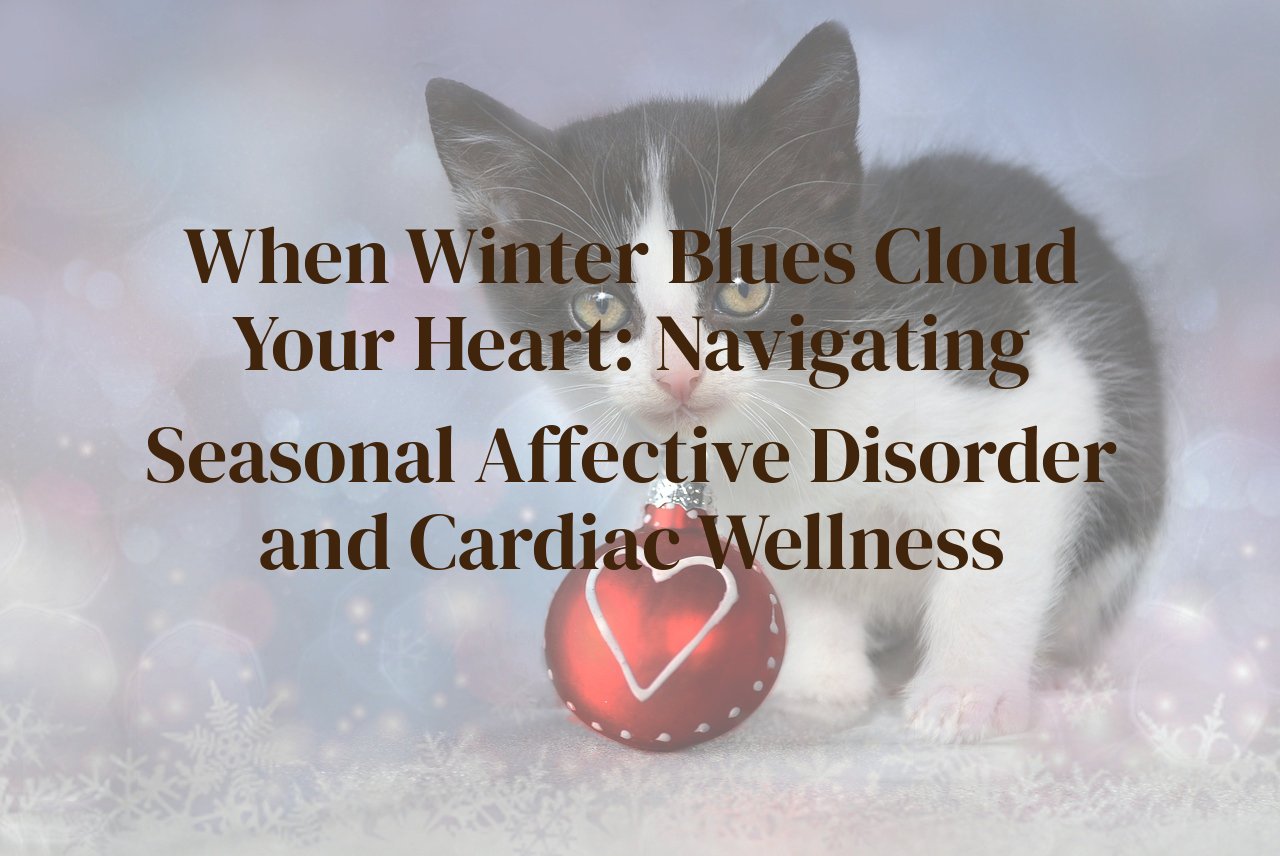
As the seasons shift, many of us find our mood ebbing and flowing with the changing tides of weather. Behind these transitory blues lies a condition rooted in the cyclic nature of the earth’s patterns: Seasonal Affective Disorder (SAD). This blog post dives into the lesser-discussed ramifications of SAD, extending beyond mental health to explore its potential impact on cardiac well-being. Delving into current research and expert insights, we’ll unravel how the frosty fingers of winter may extend a chilling touch to heart health, and empower you with actionable strategies to safeguard your cardiac wellness through the darker months.
Table of Contents
Understanding Seasonal Affective Disorder and Its Reach
Seasonal Affective Disorder (SAD) is more than just a bout of winter blues; it’s a form of depression that ebbs and flows with the seasons, typically worsening as the days grow shorter and the nights longer. The reach of SAD is both wide and deep, touching numerous lives with its chilly fingers. People with SAD experience mood changes and symptoms similar to depression. The causes are thought to be related to the reduced level of sunlight in fall and winter, which can disrupt your biological clock or circadian rhythm, affect serotonin levels – a neurotransmitter tied to mood – and lead to feelings of depression.
Key symptoms include persistent low mood, a sense of despair, lack of energy, sleeping issues, changes in appetite, and a reduced interest in activities once enjoyed. Those living at higher latitudes or with a history of depression are particularly vulnerable. SAD’s impact stretches into various spheres of life, such as work performance, personal relationships, and importantly, our physical health, with emerging research indicating a connection to cardiac wellbeing. The very heart pumping life through us can fall under a shadow with the cyclic rhythm of SAD.
While traditionally associated with winter, SAD can also occur in summer, though it is less common. The importance of recognizing and tackling SAD cannot be understated, as its tentacles can reach deep into the essence of our wellbeing, disrupting our daily lives and compounding stress, which is a known risk factor for heart disease. In this respect, understanding SAD is the first step in unwrapping the layers of seasonal melancholy to protect the heart’s harmonious beat against winter’s disruptive toll.
The Heart of the Matter: SAD’s Influence on Cardiac Health
Seasonal Affective Disorder (SAD) is more than just a winter-induced slump; it’s a psychobiological condition that can cast a heavy shadow on cardiac wellness. As winter’s short days and long nights take their toll, SAD can trigger a cascade of physiological changes, ultimately affecting heart health. The relationship between mental health and cardiovascular disease is intricate, and understanding this connection is vital for preventive health measures.
When individuals face the colder, gray months, those with SAD may experience disrupted circadian rhythms, leading to hormonal imbalances that can influence cardiovascular function. Serotonin and melatonin, neurotransmitters responsible for mood and sleep, play a role in blood pressure regulation and heart rate. Diminished sunlight can result in lower serotonin levels, potentially sparking depressive symptoms and a concurrent rise in stress hormones like cortisol, which is known for its detrimental impact on the heart by promoting hypertension and atherosclerosis.
Moreover, individuals coping with SAD often exhibit altered eating patterns, gravitating towards high-carbohydrate comfort foods that could spike insulin levels and lead to weight gain. This seasonal shift toward a less heart-healthy diet, coupled with the tendency to reduce physical activity during colder months, poses additional risks such as increased cholesterol and blood pressure, both notorious for straining the heart’s functioning.
Furthermore, SAD can influence the heart through the axis of social isolation and physical inactivity. The resulting loneliness and sedentary lifestyle may contribute to inflammation and vascular disease. Also, the emotional strain of SAD often amplifies the body’s fight or flight response, causing vasoconstriction and increased heart rate—factors associated with greater wear on the cardiovascular system and heightened risk of cardiac events.
It is, therefore, imperative to recognize the symptoms of SAD not only as a mental health concern but as a risk factor for cardiac health. The interplay between SAD and cardiovascular disease highlights the need for integrative care strategies that address mental health as a critical component of heart health. Early intervention and a multidisciplinary approach are essential in mitigating SAD’s potential risks to cardiovascular wellness during the winter months.
Winter’s Chill on The Heart: Stress Responses and Blood Pressure
The winter season, with its shorter days and longer nights, often brings with it a chill that permeates more than just the air–our bodies respond in kind, with particular implications for our cardiovascular health. One such response is the increased production of stress hormones, like cortisol and adrenaline, which are part of our primal ‘fight or flight’ mechanism. In the face of cold and diminished sunlight, these hormones can cause blood vessels to constrict, thereby raising blood pressure and putting additional strain on the heart.
This physiological reaction to stress may be compounded for individuals suffering from Seasonal Affective Disorder (SAD). The weight of SAD can amplify stress reactions, leading to heightened blood pressure and potentially exacerbating conditions like hypertension, which is already a risk factor for heart disease. Furthermore, the behavioral changes linked to SAD–such as reduced physical activity, increased food intake, and disrupted sleep patterns–can independently affect cardiovascular health, fostering a milieu in which the heart must work harder to maintain bodily functions.
In winter’s clutch, we find our cardiac wellness tested by a matrix of emotional and physical stressors. Isolation due to inclement weather, reduced opportunities for outdoor exercise, and the psychological effects of prolonged darkness can contribute to a state of chronic stress that fuels a continuous release of stress hormones, keeping blood pressure levels at a simmering high. Recognizing these intertwined responses is crucial for adopting strategies that can warm the heart’s winter burden and defrost the tight grip of seasonal stress.
Strategies to Combat SAD and Protect Your Heart
Recognizing the need for a robust defense against the encroaching gloom of Seasonal Affective Disorder (SAD) and its implications for our cardiac health, several strategies unfold like a beacon in the wintry haze. These practices acknowledge the intricate connection between our emotional and cardiovascular well-being, ushering in methods to fortify both.
Firstly, embracing the sunlight’s invigorating embrace whenever possible stands paramount. Maximizing exposure to natural light, especially in the morning, can recalibrate the body’s circadian rhythms, mitigating SAD’s symptoms and concurrently relieving the heart of undue stress. For those nestled in climes bereft of generous sunlight, light therapy emerges as a herald of hope, delivering controlled and substantial doses of artificial light to mimic the sun’s reviving qualities.
Engaging in regular physical activity is a proverbial two-pronged spear, targeting both the mood declines associated with SAD and the health of our life-sustaining heart. Exercise prompts the release of endorphins, nature’s mood elevators, while also strengthening cardiac muscles and enhancing circulation. The symbiotic relationship between a buoyant spirit and a robust heart could not be more evident than through the joy of movement.
Nurturing social connections and forging bonds of camaraderie offer a warm refuge from the isolating chill of SAD. Fostering relationships and social interactions can be a balm for the soul, relieving the heart from the unique strain that loneliness and depression can impose. The simple act of sharing a smile or laughter bridges the gaps between hearts, ensuring both emotional sustenance and cardiac resilience.
A dietary regime, rich in omega-3 fatty acids and low in processed foods, plays a subtle yet significant role. Foods abundant in omega-3s, such as fatty fish and flaxseeds, are associated with lower rates of depression and improved heart health. Traversing the gauntlet of winter does not mean forsaking the culinary joys, for it is in these flavorful selections that our hearts may find a nutritional sanctuary.
Lastly, professional support, whether it be counseling or medical intervention, should not be relegated to the shadows. Addressing SAD’s grip requires more than just the will to push through; it often warrants the guiding hand of therapy or possibly medication. As we unfurl our sails to navigate the stormy seas of SAD, it’s crucial to remember that the heart, too, deserves its crew of specialists, standing ready to preserve its vim and vigor amidst the seasonal tumult.
Holistic Approaches: Linking Mental and Cardiac Care During Seasonal Shifts
As the cold tendrils of winter wrap around us, the impact of Seasonal Affective Disorder (SAD) extends beyond the confines of mood and mental health, reaching into the realm of cardiac wellness. During these seasonal shifts, it is vital to adopt a holistic approach to healthcare, acknowledging the intrinsic connection between our mental state and heart health. Holistic care emphasizes treating the whole person, not just the symptoms, and incorporates a range of strategies.
One fundamental aspect of a holistic approach is the integration of regular physical activity into our daily routines. Exercise acts as a powerful mediator in this relationship. Not only does physical activity help to reduce the symptoms of SAD by releasing endorphins and improving mood, but it also strengthens the cardiovascular system, reduces blood pressure, and improves overall heart function.
Diet also plays a pivotal role in managing both SAD and heart health. Consuming a balanced diet rich in omega-3 fatty acids, vitamin D, and antioxidants can help alleviate depressive symptoms and support cardiac wellness. Omega-3s, for example, are known for their anti-inflammatory properties, which can protect against heart disease, while vitamin D has been linked to improved mood.
Mindfulness and meditation offer another layer of holistic defense. These practices can reduce stress and anxiety associated with SAD, leading to lower heart rates and improved blood pressure regulation. Embracing mindfulness can create a sense of calm and balance, reinforcing the resilience of both mind and heart.
Moreover, establishing strong social connections and seeking support from friends, family, or support groups can provide emotional sustenance through the darker months. Social support not only combats feelings of isolation linked with SAD but also provides a buffer against stress, which is known to take a toll on cardiac health.
Finally, professional guidance should not be overlooked. Collaborative care involving both mental health professionals and cardiologists can ensure that treatment plans are comprehensive and tailored. This might involve coordinated therapy sessions, medication management, and regular health screenings to monitor both mental and cardiac markers.
By weaving these strands of physical activity, nutrition, mindfulness, social support, and professional care into the fabric of daily life, we can construct a robust safety net. This safety net not only helps to lift the shadow of SAD but also shields the heart from the chill of winter – ensuring that as the seasons change, both our spirits and hearts remain resilient and robust.
Conclusion
As we’ve journeyed through the intersecting pathways of mental and cardiac health in the realm of seasonal changes, it is evident that SAD poses a complex risk to heart health. Yet, with each challenge arises an opportunity for growth and resilience. By proactively addressing the symptoms of Seasonal Affective Disorder, embracing lifestyle adjustments, and seeking holistic care, we can withstand the impact of the winter months and embrace a healthier heart. Let this knowledge be your guiding light through the dim days, illuminating a path toward well-being in all seasons.



